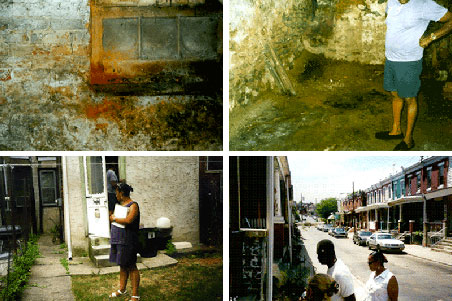
In Summer 1999, WPLP and members of the Mill Creek Coaalition's Environment Committee planned a pilot study to assess housing conditions related to flooding and subsidence on the buried floodplain of Mill Creek. Together, we chose a 10-block area within the buried floodplain in the Mill Creek neighborhood, as well as a "control" block outside the buried floodplain.
Renewed attention from the city and from the Coalition itself sparked projects to mitigate flooding in the neighborhood. The Water Department took a video of the inside of the sewer lines to identify potential sources of flooding. The Department then sealed off the connections to several abandoned sites, preventing them from contributing to any flooding in the area. The Department also showed its video at a community meeting at Sulzberger Middle School to explain the issue to residents and alleviate their concerns about the problem.
The neighborhood survey brought new attention to flooding in the Mill Creek neighborhood. The Philadelphia Inquirer got wind of the project and, with the help of Anne Whiston Spirn, connected with the residents of the surveyed homes. An editor from the newspaper visited the neighborhood to see the conditions firsthand. Shortly thereafter, Joanne Dahme from the Philadelphia Water Department connected with the Coalition to learn more about the problem. Dahme visited the neighborhood and performed her own survey, paying particular attention to the abandoned homes. Dahme explained to the Coalition that abandoned or torn down homes could be a source of flooding in the neighborhood, if the sewer and water connections are still open even after the pipes in these homes are removed.
The renewed attention from the city and from the Coalition itself sparked projects to mitigate flooding in the neighborhood. The Water Department took a video of the inside of the sewer lines to identify potential sources of flooding. The Department then sealed off the connections to several abandoned sites, preventing them from contributing to any flooding in the area. The Department also showed its video at a community meeting at Sulzberger, to explain the issue to residents and alleviate their concerns about the problem.
As the Water Department focused its efforts on the sewer, the Coalition began to consider ways to manage stormwater runoff, another potential source of flooding. Donald Fuller, a Mill Creek resident, recommended using pots to catch rainmwater as it flowed off rooftops. Following this recommendation, an initiative by the mayor chose several blocks within the neighborhood site to install gutters and downspouts to funnel storm water to the pots.